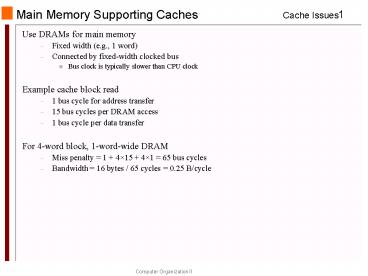Main Memory Supporting Caches PowerPoint PPT Presentation
1 / 19
Title: Main Memory Supporting Caches
1
Main Memory Supporting Caches
- Use DRAMs for main memory
- Fixed width (e.g., 1 word)
- Connected by fixed-width clocked bus
- Bus clock is typically slower than CPU clock
- Example cache block read
- 1 bus cycle for address transfer
- 15 bus cycles per DRAM access
- 1 bus cycle per data transfer
- For 4-word block, 1-word-wide DRAM
- Miss penalty 1 415 41 65 bus cycles
- Bandwidth 16 bytes / 65 cycles 0.25 B/cycle
2
Increasing Memory Bandwidth
3
Advanced DRAM Organization
- Bits in a DRAM are organized as a rectangular
array - DRAM accesses an entire row
- Burst mode supply successive words from a row
with reduced latency - Double data rate (DDR) DRAM
- Transfer on both rising and falling clock edges
- Quad data rate (QDR) DRAM
- Separate DDR inputs and outputs
4
Measuring Cache Performance
- Components of CPU time
- Program execution cycles
- Includes cache hit time
- Memory stall cycles
- Mainly from cache misses
- With simplifying assumptions
5
Cache Performance Example
- Given
- I-cache miss rate 2
- D-cache miss rate 4
- Miss penalty 100 cycles
- Base CPI (ideal cache) 2
- Load stores are 36 of instructions
- Miss cycles per instruction
- I-cache 0.02 100 2
- D-cache 0.36 0.04 100 1.44
- Actual CPI 2 2 1.44 5.44
- Ideal CPU is 5.44/2 2.72 times faster
6
Average Access Time
- Hit time is also important for performance
- Average memory access time (AMAT)
- AMAT Hit time Miss rate Miss penalty
- Example
- CPU with 1ns clock, hit time 1 cycle, miss
penalty 20 cycles, I-cache miss rate 5 - AMAT 1 0.05 20 2ns
- 2 cycles per instruction
7
Performance Summary
- When CPU performance increased
- Miss penalty becomes more significant
- Decreasing base CPI
- Greater proportion of time spent on memory stalls
- Increasing clock rate
- Memory stalls account for more CPU cycles
- Cant neglect cache behavior when evaluating
system performance
8
Associative Caches
- Fully associative
- Allow a given block to go in any cache entry
- Requires all entries to be searched at once
- Comparator per entry (expensive)
- n-way set associative
- Each set contains n entries
- Block number determines which set
- (Block number) modulo (Sets in cache)
- Search all entries in a given set at once
- n comparators (less expensive)
9
Associative Cache Example
10
Spectrum of Associativity
- For a cache with 8 entries
11
Associativity Example
- Compare 4-block caches
- Direct mapped, 2-way set associative,fully
associative - Block access sequence 0, 8, 0, 6, 8
- Direct mapped
Block address Cache index Hit/miss Cache content after access Cache content after access Cache content after access Cache content after access
Block address Cache index Hit/miss 0 1 2 3
0 0 miss Mem0
8 0 miss Mem8
0 0 miss Mem0
6 2 miss Mem0 Mem6
8 0 miss Mem8 Mem6
12
Associativity Example
- 2-way set associative
Block address Cache index Hit/miss Cache content after access Cache content after access Cache content after access Cache content after access
Block address Cache index Hit/miss Set 0 Set 0 Set 1 Set 1
0 0 miss Mem0
8 0 miss Mem0 Mem8
0 0 hit Mem0 Mem8
6 0 miss Mem0 Mem6
8 0 miss Mem8 Mem6
Fully associative
Block address Hit/miss Cache content after access Cache content after access Cache content after access Cache content after access
0 miss Mem0
8 miss Mem0 Mem8
0 hit Mem0 Mem8
6 miss Mem0 Mem8 Mem6
8 hit Mem0 Mem8 Mem6
13
How Much Associativity
- Increased associativity decreases miss rate
- But with diminishing returns
- Simulation of a system with 64KBD-cache, 16-word
blocks, SPEC2000 - 1-way 10.3
- 2-way 8.6
- 4-way 8.3
- 8-way 8.1
14
Set Associative Cache Organization
15
Replacement Policy
- Direct mapped no choice
- Set associative
- Prefer non-valid entry, if there is one
- Otherwise, choose among entries in the set
- Least-recently used (LRU)
- Choose the one unused for the longest time
- Simple for 2-way, manageable for 4-way, too hard
beyond that - Random
- Gives approximately the same performance as LRU
for high associativity
16
Multilevel Caches
- Primary cache attached to CPU
- Small, but fast
- Level-2 cache services misses from primary cache
- Larger, slower, but still faster than main memory
- Main memory services L-2 cache misses
- Some high-end systems include L-3 cache
17
Multilevel Cache Example
- Given
- CPU base CPI 1, clock rate 4GHz
- Miss rate/instruction 2
- Main memory access time 100ns
- With just primary cache
- Miss penalty 100ns/0.25ns 400 cycles
- Effective CPI 1 0.02 400 9
18
Example (cont.)
- Now add L-2 cache
- Access time 5ns
- Global miss rate to main memory 0.5
- Primary miss with L-2 hit
- Penalty 5ns/0.25ns 20 cycles
- Primary miss with L-2 miss
- Extra penalty 500 cycles
- CPI 1 0.02 20 0.005 400 3.4
- Performance ratio 9/3.4 2.6
19
Multilevel Cache Considerations
- Primary cache
- Focus on minimal hit time
- L-2 cache
- Focus on low miss rate to avoid main memory
access - Hit time has less overall impact
- Results
- L-1 cache usually smaller than a single cache
- L-1 block size smaller than L-2 block size

